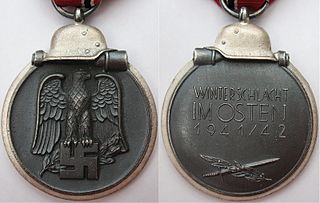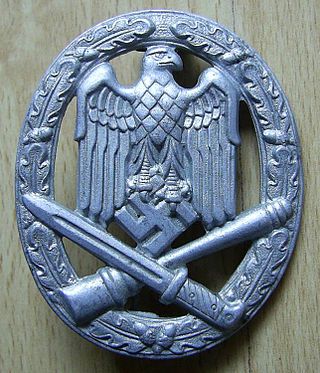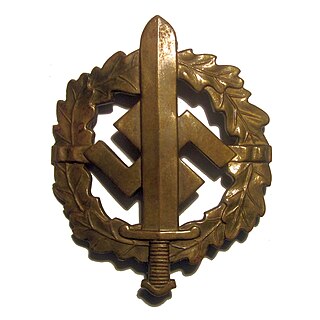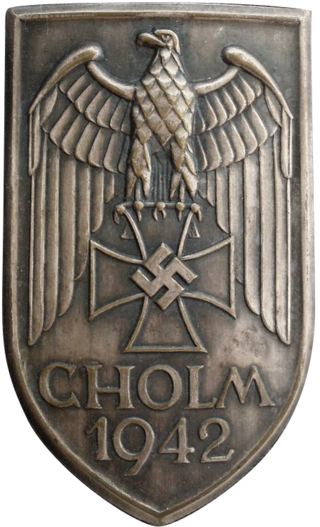
The Blood Order, officially known as the Decoration in Memory of 9 November 1923, was one of the most prestigious decorations in the Nazi Party (NSDAP). During March 1934, Hitler authorized the Blood Order to commemorate the 9 November 1923 coup attempt of the Nazi Party. The medal is silver, with the obverse bearing a depiction of an eagle grasping an oak leaf wreath. Inside the wreath is the date 9.Nov. and to the right is the inscription München 1923–1933. The reverse shows the entrance of the Feldherrnhalle in relief, and directly above is the angled swastika with sun rays in the background. Along the top edge is the inscription: UND IHR HABT DOCH GESIEGT.

The War Order of the German Cross, normally abbreviated to the German Cross or Deutsches Kreuz, was instituted by Adolf Hitler on 28 September 1941. It was awarded in two divisions: in gold for repeated acts of bravery or military leadership; and in silver for distinguished non-combat war service. The German Cross in Gold ranked higher than the Iron Cross First Class but below the Knight's Cross of the Iron Cross, while the German Cross in Silver ranked higher than the War Merit Cross First Class with Swords but below the Knight's Cross of the War Merit Cross with Swords.

The War Merit Cross was a state decoration of Nazi Germany during World War II. By the end of the conflict it was issued in four degrees and had an equivalent civil award. A "de-Nazified" version of the War Merit Cross was reissued in 1957 by the Bundeswehr for its veterans.

Demyansk Shield was a World War II German military decoration awarded to Wehrmacht personnel who fought in the Demyansk pocket on the Eastern Front in the early months of 1942. The pocket of German troops had been encircled and cut off by the Red Army around Demyansk (Demjansk), south of Leningrad, and was successfully defended with the aid of an airbridge. The shield was instituted on 25 April 1943 by Adolf Hitler and was not bestowed after 1 July 1944.

The Kuban Shield was a World War II military decoration of Nazi Germany. It was awarded to Wehrmacht forces who fought at the Kuban bridgehead in the Soviet Union from February 1943 until it was abandoned in October 1943. The award was instituted on 21 September 1943.

The Eastern Medal, officially the Winter Battle in the East 1941–42 Medal, was a military award of the Wehrmacht which was created by ordinance of Adolf Hitler on 26 May 1942.

Political decorations of the Nazi Party were medals and awards issued by the National Socialist German Workers Party (NSDAP) between 1920 and 1945. Political awards were authorised for wear on any paramilitary uniform of Nazi Germany, as well as civilian attire, but were generally discouraged on Wehrmacht military uniforms. The Waffen-SS freely wore both political awards and military decorations on their uniforms.

The 1 October 1938 Commemorative Medal was commonly known as the Sudetenland Medal. It was a decoration of Nazi Germany awarded during the interwar period, and the second in a series of Occupation Medals.

The Anschluss Commemorative Medal was a decoration of Nazi Germany awarded during the interwar period, and the first in a series of Occupation Medals.

The General Assault Badge was a military decoration awarded during World War II to personnel of the German Army, Waffen-SS and Ordnungspolizei who supported an infantry attack but were not part of specific infantry units and therefore did not qualify for the Infantry Assault Badge. It was instituted by General Walther von Brauchitsch on 1 June 1940.

SS Long Service Awards were medals that were given in grades of four years, eight years, twelve years, and twenty-five years. The four and eight-year service awards were in the form of circular medals while the 12 and 25-year service awards were in the form of swastikas. The SS service awards were designed in Munich by Professor Karl Diebitsch. The awards varied in design depending on the length of service of the recipient.

The National Faithful Service Medal was a Nazi Germany medal of honor that was founded on 30 January 1938, in three grades, to reward civilians and military in the employ of the German public services for long and faithful service.
A Service award was awarded by a country to a soldier or civilian for long service. It is comparable to a service medal but can be awarded to civilians as well as soldiers.

The Clasp to the Iron Cross was a white metal medal clasp displayed on the uniforms of German Wehrmacht personnel who had been awarded the Iron Cross in World War I, and who again qualified for the decoration in World War II.

The SA Sports Badge was a decoration of Nazi Germany that was issued between the years 1933 and 1945. It was a political version of the much more generic German Sports Badge, which was also issued in great numbers by the Nazis. At its center was a 57mm high Roman broad sword, superimposed over a Nazi swastika encircled by an wreath of oak leaves. It was a pin-back badge, but there was a cloth version, as well.

The Wehrmacht Long Service Award was a military service decoration of Nazi Germany issued for satisfactory completion of a number of years in military service.

The German Olympic Decoration was a civil decoration of Nazi Germany awarded to administrators of the IV Olympic Winter Games in Garmisch-Partenkirchen and the Games of the XI Olympiad in Berlin 1936. The award was not intended for actual participants in the Olympic Games, but rather in recognition of those who had orchestrated the "behind the scenes" preparations and work for the events.

The Nazi Party Long Service Award, sometimes called the NSDAP Long Service Award, was a political award in the form of a badge of the Nazi Party.

The Cholm Shield was a World War II German military decoration awarded to those who fought in the Cholm Pocket on the Eastern Front between 21 January and 5 May 1942. It was instituted on 1 July 1942 and is the rarest of the German combat shields, with approximately 5,500 recipients. Awards ceased to be bestowed on 1 April 1943.

The Faithful Service Medal was instituted by the State President of the Republic of Transkei in 1987, for award to all ranks as a long service medal.





















